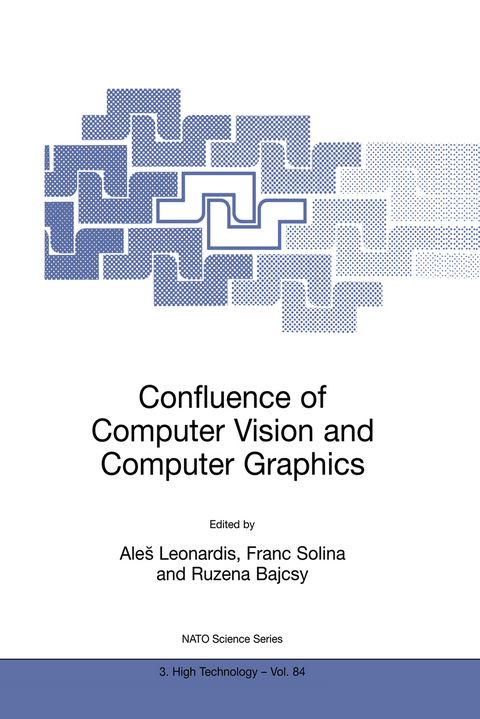
Confluence of Computer Vision and Computer Graphics
Springer (Verlag)
978-0-7923-6612-6 (ISBN)
1 From images to virtual and augmented reality.- 1. Introduction.- 2. Review: the correspondence problem over multiple views.- 3. Results.- 4. Construction of virtual-reality models for polyhedral scenes.- 5. Augmented reality.- 6. Future developments.- 2 Surface reconstruction from multiple views using apparent contours and surface texture.- 1. Introduction.- 2. Reconstruction from apparent contours.- 3. Computing the surface from texture information.- 4. Minimising reprojection errors using a surface representation.- 5. Summary.- 3 Consistent projective reconstruction from multiple views.- 1. Introduction.- 2. Problem of joining two independent projective reconstructions.- 3. Projective reconstruction from three views.- 4. Projective reconstruction from n views based on concatenation of trifocal constraints.- 5. Experiments.- 6. Summary.- Appendix A: Trifocal constraints.- Appendix B: The structure of matrix G.- 4 Accurate natural surface reconstruction from polynocular stereo.- 1. Introduction.- 2. The point-set model reconstruction.- 3. The fish-scale model reconstruction.- 4. The discrete manifold model reconstruction.- 5. Human face 3D model reconstruction.- 6. Summary.- 5 Building models from sensor data: An application shared by the computer vision and the computer graphics community.- 1. Introduction.- 2. Model building pipeline.- 3. Research themes.- 4. Conclusion.- 6 Acquiring range images of objects with non-uniform reflectance using high dynamic scale radiance maps.- 1. Introduction.- 2. Acquisition technique.- 3. Problem description.- 4. Our approach.- 5. Experimental results.- 6. Conclusion.- 7 Dynamic view interpolation without affine reconstruction.- 1. Introduction.- 2. Dynamic view morphing.- 3. Notation and preliminary concepts.- 4. View interpolation for a single moving object.- 5. Interpolation without H?.- 6. Interpolation with H?.- 7. Experimental results.- 8. Summary.- 8 Facial motion capturing using an explanation-based approach.- 1. Introduction.- 2. PBVD model.- 3. PBVD model-based tracking algorithm.- 4. Explanation-based motion tracking.- 5. Implementation and experimental results.- 6. Discussion.- 9 Image-based 3D modeling: Modeling from reality.- 1. Introduction.- 2. Two image-based 3D acquisition systems.- 3. Image-based texture synthesis.- 4. Face animation for speech.- 5. Conclusions and future work.- 10 Computer vision and graphics techniques for modeling dressed humans.- 1. Introduction.- 2. Human body reconstruction.- 3. Modeling and analysis of cloth draping.- 4. Experimental results.- 5. Conclusions.- 11 Urban site models: Accurate, detailed, rapid and inexpensive.- 1. Introduction.- 2. Source data.- 3. Work flow issues.- 4. The use of image matching.- 5. Setting up large blocks of imagery.- 6. Extracting details of building facades.- 7. Where will this lead?.- 12 Medical visualisation, biomechanics, figure animation and robot teleoperation: Themes and links.- 1. Introduction.- 2. Medical visualisation and biomechanics.- 3. Figure animation.- 4. Telecontrol of robots.- 5. Summary.- 13 Can virtual look real? A review of virtual studio techniques.- 1. Introduction.- 2. Real-time performance.- 3. Realism of computer-generated scenes.- 4. Lighting and chroma keying.- 5. Shadows.- 6. Camera tracking.- 7. Simulation of lens behavior.- 8. Distance keying.- 9. Conclusions.- 14 Real-time 3D-teleimmersion.- 1. Introduction.- 2. Related work.- 3. System description and scenario.- 4. Binocular stereo reconstruction.- 5. A novel trinocular stereo algorithm.- 6. Performance.- 7. Conclusions and thefuture.- 15 Augmented reality: A problem in need of many computer vision—based solutions.- 1. Introduction.- 2. Typical AR configurations.- 3. User tracking.- 4. 3D scene modeling for occlusion and reflection handling.- 5. Diminished reality.- 6. Mobile object tracking.- 7. Virtual user motion and telepresence.- 8. Summary.- 16 Registration methods for harmonious integration of real world and computer generated objects.- 1. Introduction.- 2. Contributions.- 3. Overview.- 4. Robust pose computation from various features (RPC algorithm).- 5. Improving the viewpoint computation.- 6. Results.- 7. Conclusion.- Appendix: The fundamental matrix.- 17 3D object tracking using analysis/synthesis techniques.- 1. Introduction.- 2. Models.- 3. Camera calibration.- 4. Definition of the object tracking parameters.- 5. Matching process.- 6. Optimization.- 7. Dynamic tracking.- 8. Experiments and results.- 9. Conclusion and future work.- 10. Summary.- 18 Augmented reality by integrating multiple sensory modalities for underwater scene understanding.- 1. Introduction.- 2. Segmentation.- 3. Extraction of cylinders.- 4. Augmented reality.- 5. Experimental results.- 6. Summary.
| Reihe/Serie | NATO Science Partnership Sub-Series: 3 ; 84 |
|---|---|
| Zusatzinfo | XL, 352 p. |
| Verlagsort | Dordrecht |
| Sprache | englisch |
| Maße | 160 x 240 mm |
| Themenwelt | Informatik ► Grafik / Design ► Digitale Bildverarbeitung |
| Informatik ► Theorie / Studium ► Künstliche Intelligenz / Robotik | |
| ISBN-10 | 0-7923-6612-3 / 0792366123 |
| ISBN-13 | 978-0-7923-6612-6 / 9780792366126 |
| Zustand | Neuware |
| Haben Sie eine Frage zum Produkt? |
aus dem Bereich


